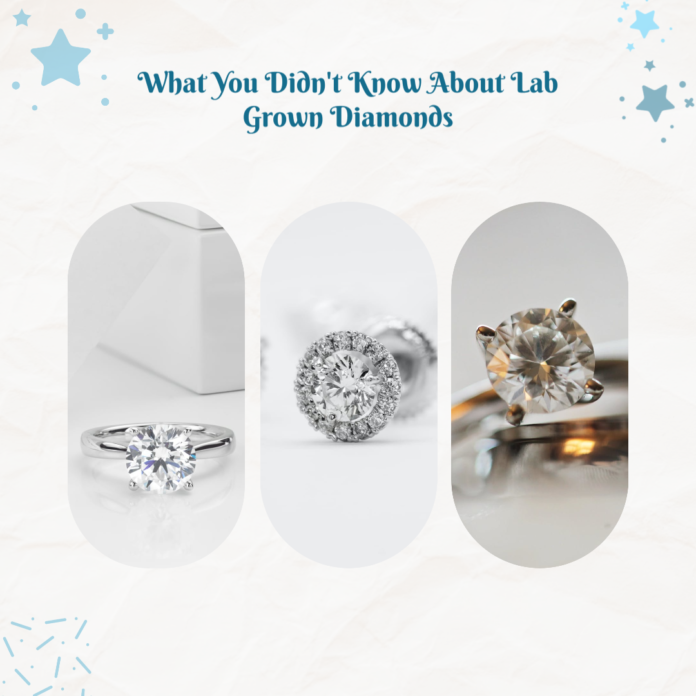Lab grown diamonds have been around since the 1950s, and they’ve been gaining popularity in recent years. But how exactly are they created? Are they really just man-made diamond substitutes? Find out everything you didn’t know about lab grown diamonds and learn why they may be the best option for an engagement ring or other jewelry purchase.
Lab Grown Diamonds Are Real
The most common misconception about lab-grown diamonds is that they’re fake, fake, FAKE! This couldn’t be further from the truth. These diamonds are not artificially manufactured by computers—they’re created by machines under incredibly strict conditions to ensure every single diamond meets its quality standards. So it’s important to understand that these diamonds were mined in the same way as your old-fashioned natural gems, but because they are grown in a laboratory rather than dug out of a mine, their origins make them appear more ethically sound. However, all that means is that you don’t have to worry about these stones being mined from an African country where profits from mining aren’t being reinvested in education or infrastructure.
Lab Grown Diamonds Are Real And Here To Stay
Contrary to what some experts are saying, lab grown diamonds are here to stay. These man-made stones might not be ideal for every occasion but they certainly have their place in today’s jewelry market. Choosing a lab grown diamond allows you to get a high quality stone without spending thousands of dollars. If you are looking for an engagement ring or something special, lab grown diamonds might be perfect for you. While there is plenty of misinformation out there about these amazing gems, here is some truth: From every angle and type imaginable to superior durability and options galore… they are here to stay! Choose Best Lab Grown Diamond Manufacturer.
How Lab Grown Diamonds Are Made?
Before we get into lab-grown diamonds vs. mined diamonds, let’s talk about how they’re made. There are three main processes that manufacturers use to create a diamond: chemical vapor deposition (CVD), plasma/high pressure (HPHT), and Molecu, lar Beam Epitaxy (MBE). CVD is by far the most common process and it has been in use since 1950 when General Electric first used it to create semiconductors. How does it work? Well, essentially manufacturers start with graphite, which is heated in a chamber where hydrogen and methane gases are added while applying extremely high temperatures—around 1,000 degrees Celsius. The result is a crystalline diamond material that can be cut and polished into gemstones.
Lab Grown Diamond Pros And Cons
- Color – it’s easier to find a D color in lab-grown diamonds than in natural ones. Most people believe that they are more attractive overall than their mined counterparts.
- Price – most consumers choose lab-grown diamonds because they’re far less expensive than their mined counterparts.
- No Ethics – many of us have ethical objections to blood diamonds, so growing your rocks is a great way to get what you want without hurting anyone else in the process!
How Do I Know If A Stone Is Real Or Fake?
The major way to determine whether a diamond is real or fake is through its cut. A diamond cut poorly will look dull and washed out, while one that has been precision-cut will sparkle and shine beautifully. However, there are some details you should be aware ototo our diamond is real or fake: -Confirm The Information On The Certificate: One easy way to determine if your lab grown diamonds are real or fake is to simply call up whoever provided you with it, asking for more information. If they’re not willing to give you more information on where they got it from, there’s a good chance that your stones are imitations.
Read Also: Top 10 Lab Grown Diamond Jewelry Trends in India
4 Major Reasons Why People Prefer Lab-Grown Diamonds
There’s a misconception that fake diamonds are somehow less valuable, less hardy, or less real than their mined counterparts. In fact, lab-grown diamonds—aka cultured diamonds—can be worth even more than their mined brethren! Here are four reasons why: • They’re conflict-free. Mined diamonds can be extracted in conditions that exploit poor workers and damage ecosystems; they also may fund warlords and terrorists. Lab-grown stones avoid these problems entirely. • They require fewer inputs (and generate fewer wastes). Growing synthetic diamonds requires far less energy per carat compared to mining natural ones—so much so that one carbon-neutral company has been able to offset all of its greenhouse gas emissions for every diamond it sells! Find Lab Created Diamond Manufacturer.

















